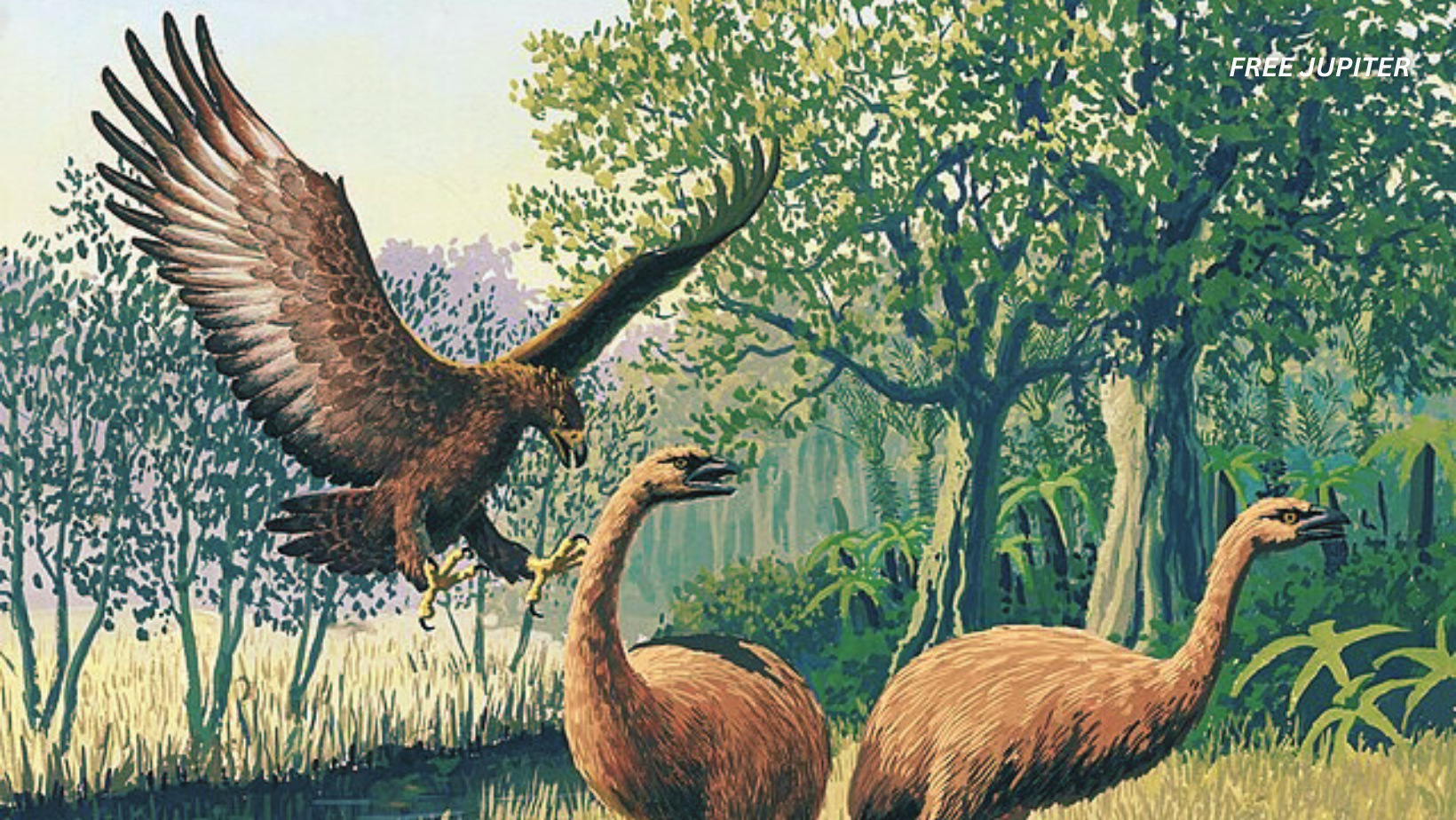Friendly Note: FreeJupiter.com shares general info for curious minds 🌟 Please fact-check all claims—and always check health matters with a professional 💙
Long before the first humans set foot on New Zealand’s shores, the islands were a realm ruled by feathers, not fur. In this isolated corner of the world, birds filled nearly every ecological niche. Instead of herds of grazing mammals, there were the moa — giant, flightless birds that roamed the forests and grasslands. And where one might expect to find lions or wolves at the top of the food chain, New Zealand boasted a truly remarkable apex predator: Haast’s eagle.
Discovery in the Swamps
The world first learned of this extraordinary bird in the late 1860s, when laborers draining a swamp unearthed enormous bones. The discovery sparked immediate curiosity among scientists. Julius Haast, the geologist and explorer who first described the species, was awestruck by the eagle’s size, labeling it a “raptorial bird of enormous dimensions.” Modern researchers estimate that Haast’s eagle could tip the scales at up to 33 pounds—making it the heaviest eagle ever known, outclassing today’s largest raptors by a wide margin. Yet, despite its bulk, its wingspan was only two to three meters, just a bit longer than that of a bald eagle, giving it a stocky, almost improbable silhouette.
The Puzzles of a Giant Bird
The eagle’s unusual proportions raised a host of questions. Could such a massive bird actually fly? Could it really have hunted the moa, some of which were more than 15 times heavier than the eagle itself? For decades, these mysteries fueled debate among scientists, as they pieced together the puzzle from scattered bones and partial skeletons.
As scientific techniques advanced, so did our understanding of this lost predator. DNA analysis and geological research have since placed Haast’s eagle at the center of a broader story about how species colonize new environments, and how ecosystems evolve in isolation.
Red more: Scientists Discover Flamingos Use Underwater Vortexes to Vacuum Up Their Prey
The Great Bird Invasion
Today, researchers believe that Haast’s eagle was part of a wave of avian newcomers that arrived in New Zealand over a relatively short period. The islands, once thought to be a biological time capsule, were actually more dynamic than previously imagined. According to Michael Knapp, a biologist at the University of Otago who has extensively studied the eagle, the story of Haast’s eagle reveals how even the most remote islands are not immune to the comings and goings of species from afar. “Natural invasions,” as Knapp calls them, are a powerful force shaping ecosystems everywhere.
A Hotbed for Extinction Studies
New Zealand has played a pivotal role in shaping scientific ideas about extinction. When European naturalists first encountered the moa, the concept that entire species could vanish forever was still relatively new. Moa skeletons quickly became prized collectibles, so much so that museums like the Canterbury Museum in Christchurch, founded by Haast himself, built their initial collections by trading these fossils for other scientific treasures.
The islands’ living oddities—like the kiwi, a flightless bird with whisker-like feathers—along with the extinct moa, helped cement New Zealand’s reputation as a “lost world,” a place where ancient life forms survived the cataclysms that wiped out their relatives elsewhere. Geologists later confirmed that New Zealand had once been part of the supercontinent Gondwana, which began breaking apart around 80 million years ago. The idea that New Zealand was a biological “ark” was popularized in the 1990s, capturing the public imagination.
The Oligocene Drowning Debate
By the end of the 20th century, however, a new theory emerged. Geological and climatic evidence suggested that, about 25 million years ago during the Oligocene epoch, rising seas may have submerged nearly all of New Zealand. If true, this “Oligocene drowning” would have wiped the biological slate clean, forcing any surviving species to recolonize the islands once the waters receded. This idea was hotly contested among scientists, sparking debates over how much land, if any, remained above water.
Read more: These 6 Chinese Zodiac Signs Are Set to Receive Major Good Fortune on May 17, 2025
DNA Unlocks the Past
The advent of ancient DNA analysis offered a way to test these ideas. By extracting genetic material from fossils and comparing it to the DNA of living species, researchers could reconstruct evolutionary family trees and estimate when different lineages diverged. In 2005, a team of scientists compared DNA from Haast’s eagle fossils to that of 16 modern eagle species. The results were surprising: Haast’s eagle’s closest living relatives were not the massive wedge-tailed eagles of Australia, as many had assumed, but rather the much smaller booted eagle and little eagle, species that weigh just a couple of pounds.
This meant that, in evolutionary terms, Haast’s eagle had ballooned in size at an astonishing rate. Genetic evidence indicates that its lineage split from its smaller cousins around 2.2 million years ago, a blink of an eye in evolutionary time. Such rapid growth is rare in the natural world and usually seen only in domesticated animals, where humans have actively selected for size.
Why Did Haast’s Eagle Get So Big?
What could have driven this dramatic transformation? The answer lies in New Zealand’s unique environment. When the ancestors of Haast’s eagle first arrived – likely blown across the Tasman Sea from Australia, they found an ecosystem overflowing with opportunity. The islands were home to the moa, which ranged in size from large turkeys to towering, ostrich-like giants. With no land mammals to compete with, the eagle’s ancestors faced little competition for this untapped bounty of meat.
While smaller raptors could prey on the islands’ smaller birds, the moa were simply too big for most predators. Natural selection thus favored eagles that could take down larger and larger prey. Over generations, this led to the evolution of a bird that was not only the largest eagle ever, but also one of the most formidable avian predators in history.
The Genetics of Gigantism
Knapp and his colleagues are now delving even deeper, comparing the genomes of various eagle species to pinpoint the genetic changes that enabled Haast’s eagle to grow so rapidly. “Understanding the molecular mechanisms behind this transformation is the next frontier,” Knapp explains. By unraveling these genetic secrets, scientists hope to shed light on how evolution can sometimes produce giants in a remarkably short time.
Echoes in Other Birds
Haast’s eagle is not the only New Zealand bird to undergo such a transformation. Eyles’s harrier, another extinct raptor, was the largest harrier ever known. Like Haast’s eagle, Eyles’s harrier evolved from a much smaller ancestor, with its closest living relative being nearly five times lighter. Genetic studies suggest that both birds’ lineages diverged from their relatives within a similar timeframe — around 2.4 million years ago.
Intrigued by this pattern, Knapp and his colleagues began searching for other examples of rapid divergence among New Zealand’s birds. They found that many of these evolutionary leaps occurred around the same time, suggesting a broader ecological shift was underway.
The Changing Face of New Zealand
What was happening in New Zealand’s environment to trigger this wave of avian evolution? Around 10 million years ago, Australia began to dry out, while New Zealand remained cloaked in dense forests. But about 2.5 million years ago, the onset of the ice ages brought colder temperatures and glaciers to New Zealand’s mountains. Many forests vanished, replaced by open grasslands — a brand-new habitat for birds adapted to open spaces.
This environmental transformation created opportunities for new arrivals. Birds from Australia, accustomed to open habitats, could now find suitable niches in New Zealand. Those that arrived at just the right time, like the ancestors of Haast’s eagle and Eyles’s harrier, flourished and evolved rapidly to fill the vacant ecological roles.
Read more: The Real Reason Some Cats Are Orange, Stanford Scientists Finally Solve Century-Old Mystery
The Extinction of a Titan
So, what ultimately led to the demise of Haast’s eagle? The answer is closely tied to the fate of the moa. As humans hunted the moa to extinction, the eagle lost its primary food source. Some researchers speculate that people may have hunted the eagles themselves, but the loss of the moa alone would have been enough to doom such a specialized predator. As Knapp notes, when a species becomes highly adapted to a specific niche, it becomes vulnerable if that niche disappears.
A Cautionary Tale from the Past
Haast’s eagle stands as a symbol of both nature’s creativity and its vulnerability. Its story reminds us that evolution can take surprising turns, producing giants and oddities in the right conditions. But it also shows that even the mightiest creatures can be brought down by sudden changes in their environment — whether those changes are natural or brought about by humans.
As new species continue to arrive in New Zealand and elsewhere, filling the gaps left by those that have vanished, the saga of Haast’s eagle serves as both a testament to life’s resilience and a warning about the consequences of disrupting delicate ecological balances.










